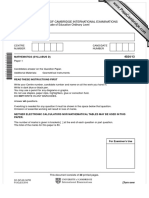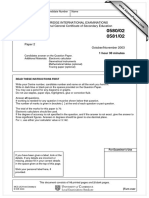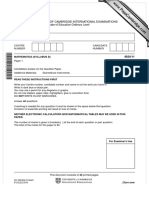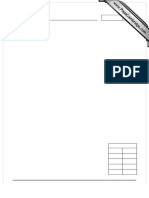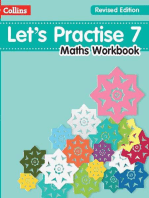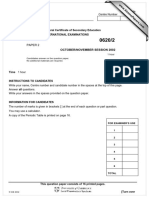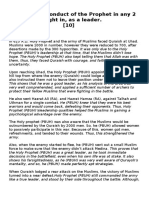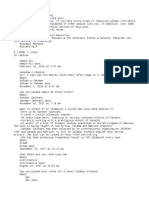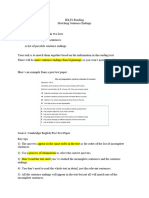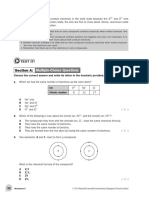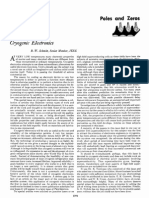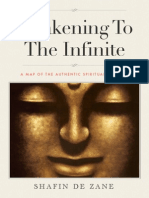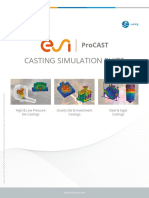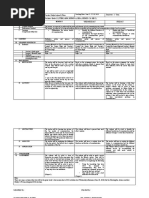University of Cambridge International Examinations International General Certificate of Secondary Education
University of Cambridge International Examinations International General Certificate of Secondary Education
Uploaded by
HACK APK KING ANDROID AND PC DUDE OFFICIALCopyright:
Available Formats
University of Cambridge International Examinations International General Certificate of Secondary Education
University of Cambridge International Examinations International General Certificate of Secondary Education
Uploaded by
HACK APK KING ANDROID AND PC DUDE OFFICIALOriginal Title
Copyright
Available Formats
Share this document
Did you find this document useful?
Is this content inappropriate?
Copyright:
Available Formats
University of Cambridge International Examinations International General Certificate of Secondary Education
University of Cambridge International Examinations International General Certificate of Secondary Education
Uploaded by
HACK APK KING ANDROID AND PC DUDE OFFICIALCopyright:
Available Formats
w
w
w
.X
tr
me
eP
ap
UNIVERSITY OF CAMBRIDGE INTERNATIONAL EXAMINATIONS
er
s
International General Certificate of Secondary Education
.c
om
MATHEMATICS
*058001*
Paper 3 (Core) 0580/03 0581/03
Candidates answer on the Question Paper.
Additional Materials: Electronic calculator
Geometrical instruments October/November 2005
Mathematical tables (optional)
Tracing paper (optional) 2 hours
Candidate
Name
Centre Candidate
Number Number
READ THESE INSTRUCTIONS FIRST
Write your Centre number, candidate number and name on all the work you hand in.
Write in dark blue or black pen in the spaces provided on the Question Paper.
You may use a pencil for any diagrams or graphs.
Do not use staples, paper clips, highlighters, glue or correction fluid.
DO NOT WRITE IN THE BARCODE.
DO NOT WRITE IN THE GREY AREAS BETWEEN THE PAGES.
Answer all questions.
If working is needed for any question it must be shown below that question.
The number of marks is given in brackets [ ] at the end of each question or part question.
For Examiner's Use
The total number of marks for this paper is 104.
Electronic calculators should be used.
If the degree of accuracy is not specified in the question, and if the answer is
not exact, give the answer to three significant figures. Given answers
in degrees to one decimal place.
For π , use either your calculator value or 3.142.
This document consists of 12 printed pages.
IB05 11_0580_03/7RP
© UCLES 2005 [Turn over
2
1 (a) Draw accurately the reflection of the letter E in the mirror line m. For
Examiner's
Use
m
[2]
(b) Each diagram below shows a shaded letter and its image.
In each case describe fully the single transformation which maps the shaded figure onto its image.
Mark and label any points you need in your descriptions.
(i)
Answer(b)(i) [3]
(ii)
Answer(b)(ii) [3]
(iii)
y
x
–6 –4 –2 0 2 4 6
–2
–4
Answer(b)(iii) [3]
© UCLES 2005 0580/03, 0581/03 Nov 2005
3
2 In the diagram below ABD is a straight line. For
AB = 4 m and AC = 6 m. Angle BAC = 90°. Examiner's
Use
A 4m B D
NOT TO
6m SCALE
(a) (i) Use trigonometry to calculate angle ABC.
Answer(a)(i) Angle ABC= [2]
(ii) Find angle CBD.
Answer(a)(ii) Angle CBD= [1]
(b) Calculate the length of BC.
Answer(b) BC = m [2]
(c) Work out the perimeter and area of triangle ABC.
Give the correct units for each.
Answer (c) Perimeter = Area = [3]
© UCLES 2005 0580/03, 0581/03 Nov 2005 [Turn over
4
3 (a) (i) Complete the table of values for y = x 2 − 2 x − 3 . For
Examiner's
Use
x −3 −2 −1 0 1 2 3 4 5
y 12 0 −4 −3 0 5
[3]
(ii) Draw the graph of y = x 2 − 2 x − 3 on the grid below.
y
12
10
x
–3 –2 –1 0 1 2 3 4 5
–2
–4
[4]
2
(iii) Use your graph to find the solutions to x − 2 x − 3 = −1 .
Give your answers to 1 decimal place.
Answer(a)(iii) x = or x = [2]
2
(b) (i) Complete the table of values for the equation y = x .
x 0.25 0.5 1 2 3 4 5
y 4 1 0.7 0.5 0.4
[1]
2
(ii) On the same grid draw the graph of y = x for 0.25 x 5. [3]
(iii) Write down the x co-ordinate of the point of intersection of your two graphs.
Answer(b)(iii) x = [1]
© UCLES 2005 0580/03, 0581/03 Nov 2005
5
4 Jane records the number of telephone calls she receives each day for two weeks. For
Examiner's
5 6 10 0 15 6 12 2 13 16 0 16 6 10 Use
(a) Calculate the mean.
Answer(a) [3]
(b) Find the median.
Answer(b) [2]
(c) Write down the mode.
Answer(c) [1]
(d) Complete the frequency table below.
Number of calls 0−4 5−9 10 − 14 15 − 19
Frequency
[2]
(e) Find the probability that Jane receives
(i) ten or more calls,
Answer(e)(i) [1]
(ii) less than five calls.
Answer(e)(ii) [1]
(f) Estimate the number of days in the next six weeks that Jane can expect to receive 10 − 14 calls.
Answer(f) days [2]
© UCLES 2005 0580/03, 0581/03 Nov 2005 [Turn over
6
5 For
North Examiner's
Use
A
110o 6 km
5 km
NOT TO
C SCALE
In triangle ABC, AB = 5 km, AC = 6 km and angle BAC = 110º.
The bearing of C from A is 100°.
(a) Make a scale drawing of the triangle ABC.
Use a scale of 1 centimetre to represent 1 kilometre.
Start at the point A marked below, where a North line has been drawn.
North
[4]
© UCLES 2005 0580/03, 0581/03 Nov 2005
7
(b) Measure and write down For
Examiner's
(i) angle ABC, Use
Answer(b)(i) Angle ABC = [1]
(ii) the bearing of B from C.
Answer(b)(ii) [1]
(c) Find the distance in kilometres between B and C.
Answer(c) km [1]
(d) A well is 4 kilometres from A and 5 kilometres from C.
(i) Use your compasses to find two possible positions for the well.
Label the two positions P and Q. [3]
(ii) The well is less than 6 kilometres from B.
Use a measurement from your drawing to complete the following statement.
Answer(d)(ii) The well is at position and is kilometres from B.[2]
© UCLES 2005 0580/03, 0581/03 Nov 2005 [Turn over
8
6 The diagram shows a swimming pool with cross-section ABCDE. For
The pool is 6 metres long and 3 metres wide. Examiner's
AB = 2 m, ED = 1 m and BC = 3.6 m. Use
6m
3m
NOT TO
1m
SCALE
E
A
2m
D
B C
3.6 m
(a) (i) Calculate the area of the cross-section ABCDE.
Show your working.
Answer(a)(i) m2 [4]
(ii) Calculate the volume of the water in the pool when it is full.
Give your answer in litres.
[1 cubic metre is 1000 litres.]
Answer(a)(ii) litres [2]
(iii) One litre of water evaporates every hour for each square metre of the water surface.
How many litres of water will evaporate in 2 hours?
Answer(a)(iii) litres [2]
© UCLES 2005 0580/03, 0581/03 Nov 2005
9
For
(b) Another pool holds 61 500 litres of water. Examiner's
Jon uses a hosepipe to fill this pool. Use
Water flows through the hosepipe at 1000 litres per hour.
(i) Calculate how long it takes to fill the pool.
Give your answer in hours and minutes.
Answer(b)(i) hours minutes [2]
(ii) Change 61 500 litres to gallons.
[4.55 litres = 1 gallon.]
Answer(b)(ii) gallons [1]
(iii) Every 10 000 gallons of water needs 2.5 litres of purifier.
How many litres of purifier does Jon use for this pool?
Answer(b)(iii) litres [2]
(iv) The purifier is sold in 1 litre bottles.
How many bottles of purifier must Jon buy for this pool?
Answer(b)(iv) [1]
© UCLES 2005 0580/03, 0581/03 Nov 2005 [Turn over
10
7 (a) For
y Examiner's
Use
3
x
–3 –2 –1 0 1 2 3 4 5
–1
–2
–3
–4
–5
The simultaneous equations 2x − y = 3 and x + y = 2 can be solved graphically.
(i) Which of these equations is shown by the line on the grid above?
Answer(a)(i) [1]
(ii) Find the gradient of the line on the grid.
Answer(a)(ii) [2]
(iii) Complete the table below for the other equation.
x −1 0 1 2 3
y
[2]
(iv) Draw this line on the grid above. [1]
(v) Use your graphs to write down the solution to the two equations.
Give your values correct to 1 decimal place.
Answer(a)(v) x =
y= [3]
© UCLES 2005 0580/03, 0581/03 Nov 2005
11
(b) Use algebra to solve the following simultaneous equations exactly. For
Show all your working. Examiner's
Use
2x − y = 3,
x + y = 2.
Answer(b) x =
y= [4]
8 The diagram below shows a sequence of patterns made from dots and lines.
1 dot 2 dots 3 dots 4 dots
(a) Draw the next pattern in the sequence in the space above. [1]
(b) Complete the table for the numbers of dots and lines.
Dots 1 2 3 4 5 6
Lines 4 7 10
[2]
(c) How many lines are in the pattern with 99 dots?
Answer(c) [2]
(d) How many lines are in the pattern with n dots?
Answer(d) [2]
(e) Complete the following statement.
There are 85 lines in the pattern with dots. [2]
© UCLES 2005 0580/03, 0581/03 Nov 2005 [Turn over
12
9 (a) Calculate the size of one exterior angle of a regular heptagon (seven-sided polygon). For
Give your answer correct to 1 decimal place. Examiner's
Use
Answer(a) [3]
(b)
D A E
o
so ro t
NOT TO
SCALE
130o po qo
F B C G
In the diagram above, DAE and FBCG are parallel lines.
AC = BC and angle FBA = 130°.
(i) What is the special name given to triangle ABC?
Answer(b)(i) [1]
(ii) Work out the values of p, q, r, s and t.
Answer (b)(ii) p= q= r= s= t= [5]
(c)
J
J, K and L lie on a circle centre O. yo L
KOL is a straight line and angle JKL = 65°. NOT TO
Find the value of y. 65o O SCALE
K
Answer(c) y = [2]
Permission to reproduce items where third-party owned material protected by copyright is included has been sought and cleared where possible. Every
reasonable effort has been made by the publisher (UCLES) to trace copyright holders, but if any items requiring clearance have unwittingly been included,
the publisher will be pleased to make amends at the earliest possible opportunity.
University of Cambridge International Examinations is part of the University of Cambridge Local Examinations Syndicate (UCLES), which is itself a
department of the University of Cambridge.
© UCLES 2005 0580/03, 0581/03 Nov 2005
You might also like
- Copyright Is A Bundle of RightsDocument22 pagesCopyright Is A Bundle of RightsMG MaheshBabuNo ratings yet
- 0580 s13 QP 32Document16 pages0580 s13 QP 32Pichakorn0% (1)
- University of Cambridge International Examinations: General Certificate of Education Ordinary LevelDocument20 pagesUniversity of Cambridge International Examinations: General Certificate of Education Ordinary LevelKhan MuddassirNo ratings yet
- Cambridge Ordinary LevelDocument20 pagesCambridge Ordinary LevelYasir RahimNo ratings yet
- 0580 s12 QP 11 PDFDocument12 pages0580 s12 QP 11 PDFRunWellNo ratings yet
- Cambridge Ordinary LevelDocument24 pagesCambridge Ordinary Leveljacob learNo ratings yet
- Islamiat PDFDocument20 pagesIslamiat PDFabdulrehman098134No ratings yet
- University of Cambridge International Examinations: General Certificate of Education Ordinary LevelDocument20 pagesUniversity of Cambridge International Examinations: General Certificate of Education Ordinary LevelKhan MuddassirNo ratings yet
- Mathematics O Level 2010 Question PaperDocument20 pagesMathematics O Level 2010 Question PapernurlNo ratings yet
- University of Cambridge International Examinations International General Certificate of Secondary EducationDocument16 pagesUniversity of Cambridge International Examinations International General Certificate of Secondary EducationSidumo DlaloseNo ratings yet
- 0580 w09 QP 22Document12 pages0580 w09 QP 22Lavan NimsNo ratings yet
- Cambridge Ordinary LevelDocument20 pagesCambridge Ordinary LevelRonaldoNo ratings yet
- 0607 s11 QP 6Document8 pages0607 s11 QP 6Abhay BhingradiaNo ratings yet
- Cambridge International Examinations General Certificate of Education Ordinary LevelDocument16 pagesCambridge International Examinations General Certificate of Education Ordinary LevelJoan BandaNo ratings yet
- Cambridge International Examinations General Certificate of Education Ordinary LevelDocument16 pagesCambridge International Examinations General Certificate of Education Ordinary Levelshanezehra151214No ratings yet
- Cambridge International General Certificate of Secondary EducationDocument12 pagesCambridge International General Certificate of Secondary EducationChryssa EconomouNo ratings yet
- 4024 s11 QP 11Document20 pages4024 s11 QP 11imanNo ratings yet
- Mathematics P1 June 2008 CambridgeDocument16 pagesMathematics P1 June 2008 CambridgeTafadzwa NyazorweNo ratings yet
- University of Cambridge International Examinations International General Certificate of Secondary EducationDocument12 pagesUniversity of Cambridge International Examinations International General Certificate of Secondary EducationNaveen KumarNo ratings yet
- Question PaperDocument24 pagesQuestion PaperPranav PurawooNo ratings yet
- Microsoft Word - LIBS - TASK OIGMATHS 11 - 0580 - 32 2012Document16 pagesMicrosoft Word - LIBS - TASK OIGMATHS 11 - 0580 - 32 2012Kanchan Chugh MehraNo ratings yet
- University of Cambridge International Examinations: General Certificate of Education Ordinary LevelDocument24 pagesUniversity of Cambridge International Examinations: General Certificate of Education Ordinary LevelAbdul moiz WaheedNo ratings yet
- Mathematics: Cambridge International Examinations International General Certificate of Secondary EducationDocument12 pagesMathematics: Cambridge International Examinations International General Certificate of Secondary EducationCynthia YeungNo ratings yet
- 4024 s04 QP 1Document16 pages4024 s04 QP 1Imran Niaz KhanNo ratings yet
- University of Cambridge International Examinations: General Certificate of Education Ordinary LevelDocument20 pagesUniversity of Cambridge International Examinations: General Certificate of Education Ordinary LevelKhizr Siddiqui MuhammadNo ratings yet
- Question PaperDocument20 pagesQuestion PaperPranav PurawooNo ratings yet
- University of Cambridge International Examinations International General Certifi Cate of Secondary EducationDocument20 pagesUniversity of Cambridge International Examinations International General Certifi Cate of Secondary EducationEka YunianaNo ratings yet
- Cambridge International General Certificate of Secondary EducationDocument16 pagesCambridge International General Certificate of Secondary Educationpraiseibrahim12No ratings yet
- University of Cambridge International Examinations International General Certificate of Secondary EducationDocument24 pagesUniversity of Cambridge International Examinations International General Certificate of Secondary EducationWayne WeiNo ratings yet
- University of Cambridge International Examinations International General Certificate of Secondary EducationDocument12 pagesUniversity of Cambridge International Examinations International General Certificate of Secondary EducationFuturistic SoundNo ratings yet
- University of Cambridge International Examinations: General Certificate of Education Ordinary LevelDocument20 pagesUniversity of Cambridge International Examinations: General Certificate of Education Ordinary LevelAspire O/A levelNo ratings yet
- University of Cambridge International Examinations General Certificate of Education Ordinary LevelDocument12 pagesUniversity of Cambridge International Examinations General Certificate of Education Ordinary LevelnagayikibNo ratings yet
- Science: Cambridge International Examinations General Certificate of Education Ordinary LevelDocument12 pagesScience: Cambridge International Examinations General Certificate of Education Ordinary LevelNkhata WizzasNo ratings yet
- 0580 w10 QP 41Document16 pages0580 w10 QP 41Kevin DanyNo ratings yet
- University of Cambridge International Examinations International General Certificate of Secondary EducationDocument16 pagesUniversity of Cambridge International Examinations International General Certificate of Secondary EducationagbenipatrickNo ratings yet
- University of Cambridge International Examinations International General Certificate of Secondary EducationDocument8 pagesUniversity of Cambridge International Examinations International General Certificate of Secondary EducationM.S.Samruti TIPSNo ratings yet
- 0580 s08 QP 3Document16 pages0580 s08 QP 3Hubbak Khan100% (2)
- 0581 w13 QP 43Document20 pages0581 w13 QP 43abhayNo ratings yet
- Physics: PAPER 3 Practical Test Answer BookletDocument8 pagesPhysics: PAPER 3 Practical Test Answer Booklethumaehtesham88No ratings yet
- Cambridge International Examinations International General Certificate of Secondary EducationDocument12 pagesCambridge International Examinations International General Certificate of Secondary EducationChong Xue ErNo ratings yet
- 0580 w11 QP 21Document12 pages0580 w11 QP 21Talha RafiqNo ratings yet
- 0607 s15 QP 43Document20 pages0607 s15 QP 43Philip WhiteNo ratings yet
- Cambridge International Examinations International General Certificate of Secondary EducationDocument16 pagesCambridge International Examinations International General Certificate of Secondary EducationChong Xue ErNo ratings yet
- Science: University of Cambridge International Examinations General Certificate of Education Ordinary LevelDocument12 pagesScience: University of Cambridge International Examinations General Certificate of Education Ordinary LevelNkhata WizzasNo ratings yet
- 4024_w05_qp_1Document16 pages4024_w05_qp_1Izumi HereNo ratings yet
- Mathematics (Syllabus D)Document16 pagesMathematics (Syllabus D)Khan MuddassirNo ratings yet
- Physics: PAPER 5 Practical Test Answer BookletDocument8 pagesPhysics: PAPER 5 Practical Test Answer BookletTr AstellaNo ratings yet
- 0580 s10 QP 11Document8 pages0580 s10 QP 11StanleyNo ratings yet
- University of Cambridge International Examinations General Certificate of Education Ordinary LevelDocument12 pagesUniversity of Cambridge International Examinations General Certificate of Education Ordinary Levelyv4s94vrkpNo ratings yet
- 0581 s12 QP 21Document12 pages0581 s12 QP 21abhayNo ratings yet
- University of Cambridge International Examinations International General Certifi Cate of Secondary EducationDocument16 pagesUniversity of Cambridge International Examinations International General Certifi Cate of Secondary Educationibrahim.adham.abNo ratings yet
- 0625 s06 QP 6Document12 pages0625 s06 QP 6lylanNo ratings yet
- University of Cambridge International Examinations International General Certificate of Secondary EducationDocument16 pagesUniversity of Cambridge International Examinations International General Certificate of Secondary EducationbarbraberthaNo ratings yet
- Let's Practise: Maths Workbook Coursebook 7From EverandLet's Practise: Maths Workbook Coursebook 7No ratings yet
- Explorations and Discoveries in Mathematics, Volume 1, Using The Geometer's Sketchpad Version 4From EverandExplorations and Discoveries in Mathematics, Volume 1, Using The Geometer's Sketchpad Version 4No ratings yet
- MathsTraks: Geometry: A Collection of Blackline Masters for ages 11-14From EverandMathsTraks: Geometry: A Collection of Blackline Masters for ages 11-14No ratings yet
- 10+2 Level Mathematics For All Exams GMAT, GRE, CAT, SAT, ACT, IIT JEE, WBJEE, ISI, CMI, RMO, INMO, KVPY Etc.From Everand10+2 Level Mathematics For All Exams GMAT, GRE, CAT, SAT, ACT, IIT JEE, WBJEE, ISI, CMI, RMO, INMO, KVPY Etc.No ratings yet
- MARK SCHEME For The November 2005 Question PaperDocument6 pagesMARK SCHEME For The November 2005 Question PaperHACK APK KING ANDROID AND PC DUDE OFFICIALNo ratings yet
- MARK SCHEME For The November 2005 Question PapersDocument4 pagesMARK SCHEME For The November 2005 Question PapersHACK APK KING ANDROID AND PC DUDE OFFICIALNo ratings yet
- Mathematics October/November Session 2002Document8 pagesMathematics October/November Session 2002priyankNo ratings yet
- Chemistry: Paper 2 October/November Session 2002Document16 pagesChemistry: Paper 2 October/November Session 2002HACK APK KING ANDROID AND PC DUDE OFFICIALNo ratings yet
- Internal Examinations International General Certificate For Secondary Education (Igcse-Ii)Document7 pagesInternal Examinations International General Certificate For Secondary Education (Igcse-Ii)HACK APK KING ANDROID AND PC DUDE OFFICIALNo ratings yet
- 2 Battles Fought As A LeaderDocument3 pages2 Battles Fought As A LeaderHACK APK KING ANDROID AND PC DUDE OFFICIAL25% (4)
- BizhammadDocument3 pagesBizhammadHACK APK KING ANDROID AND PC DUDE OFFICIALNo ratings yet
- IELTS Reading Matchıng Sentence Halves STDTSDocument7 pagesIELTS Reading Matchıng Sentence Halves STDTSDeniz TokgozNo ratings yet
- Jur 12Document47 pagesJur 12propanejeNo ratings yet
- Mechanical Design of Leg MechanismDocument6 pagesMechanical Design of Leg MechanismBinyam HabtamuNo ratings yet
- Experiment 7 Molecular Geometry 7.1 Objectives: SKU3073 Chemistry Semester 1 2020/2021Document6 pagesExperiment 7 Molecular Geometry 7.1 Objectives: SKU3073 Chemistry Semester 1 2020/2021Maldini JosnonNo ratings yet
- Intro To Geography of ThoughtDocument11 pagesIntro To Geography of ThoughtJosiah Samuel MoragaNo ratings yet
- Brief Introduction of CNPC JPECDocument42 pagesBrief Introduction of CNPC JPECMaria Fernanda Bonilla SalasNo ratings yet
- WinCC Flexible Compatibility List eDocument4 pagesWinCC Flexible Compatibility List eJones ChristianNo ratings yet
- Prerna NTCC ReportDocument20 pagesPrerna NTCC ReportPrerna RoyNo ratings yet
- 444323735-Chem-Matters-Workbook-2E-Teacher-s-Edn-pdf 38-38Document1 page444323735-Chem-Matters-Workbook-2E-Teacher-s-Edn-pdf 38-38whatisNo ratings yet
- Organizational Behavior: Emotions and MoodsDocument18 pagesOrganizational Behavior: Emotions and MoodsAtif Ul Islam100% (1)
- 4.1 Case Study Based AssignmentDocument4 pages4.1 Case Study Based AssignmentfaysalNo ratings yet
- D6B1004410 MKT 001Document6 pagesD6B1004410 MKT 001Janderson Sanchez CastañedaNo ratings yet
- ECE199R-C12 Final Document OJTDocument48 pagesECE199R-C12 Final Document OJTRigel ZabateNo ratings yet
- Cryogenic Electronics: Poles and ZerosDocument1 pageCryogenic Electronics: Poles and ZerosMadhu JbNo ratings yet
- Product Disclosure Sheet - Time DepositDocument5 pagesProduct Disclosure Sheet - Time DepositangeloryanNo ratings yet
- C112-96 AE Specification1Document1 pageC112-96 AE Specification1DIGIART Design Jogja - DigiSOUNDNo ratings yet
- Awakening To The InfiniteDocument13 pagesAwakening To The InfiniteOana BaraianNo ratings yet
- Ch11 1 Transition Metals Absorption SpectraDocument29 pagesCh11 1 Transition Metals Absorption SpectraTapas GhatakNo ratings yet
- Casting Brochure 1 PDFDocument12 pagesCasting Brochure 1 PDFAkshayNo ratings yet
- Problem Solving and Decision MakingDocument2 pagesProblem Solving and Decision MakingsuhadNo ratings yet
- Oral Communication: Sections: Grade 11 (STEM, ABM, HUMSS-A, HE-A, HUMSS-C & HE-C)Document2 pagesOral Communication: Sections: Grade 11 (STEM, ABM, HUMSS-A, HE-A, HUMSS-C & HE-C)Gladyz Artjane Quilab Flores - CastilloNo ratings yet
- 999 Product GuideDocument83 pages999 Product GuideWesley Delai CruzNo ratings yet
- Politeness in American JapaneseDocument400 pagesPoliteness in American JapaneseAmal MchNo ratings yet
- PM Handbook - Business Club, IIT BHUDocument54 pagesPM Handbook - Business Club, IIT BHUYOGESH GUTTA 5-Yr IDD Material Sci. & Tech.No ratings yet
- Roland TR-808 Service ManualDocument16 pagesRoland TR-808 Service Manualboxertwin77No ratings yet
- Design of Deep Beam by Strut and Tie Method and Fluxural Theory - Civil Engineering Ryerson Assignment 3-bDocument14 pagesDesign of Deep Beam by Strut and Tie Method and Fluxural Theory - Civil Engineering Ryerson Assignment 3-bAfzal Waseem100% (1)
- Star CompatilbiltyDocument3 pagesStar Compatilbiltypurinaresh85No ratings yet
- Implementing Global PayrollDocument500 pagesImplementing Global Payrollhanushacse13No ratings yet
- Progressions & Transits PDFDocument13 pagesProgressions & Transits PDFArthur SantosNo ratings yet


